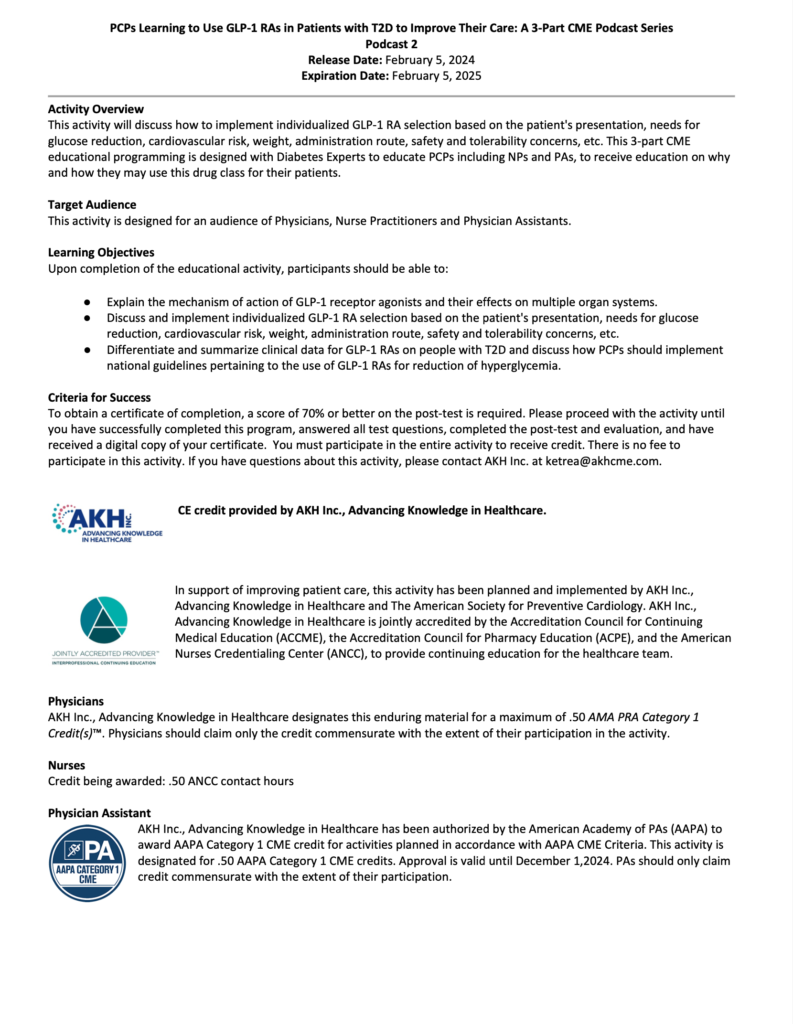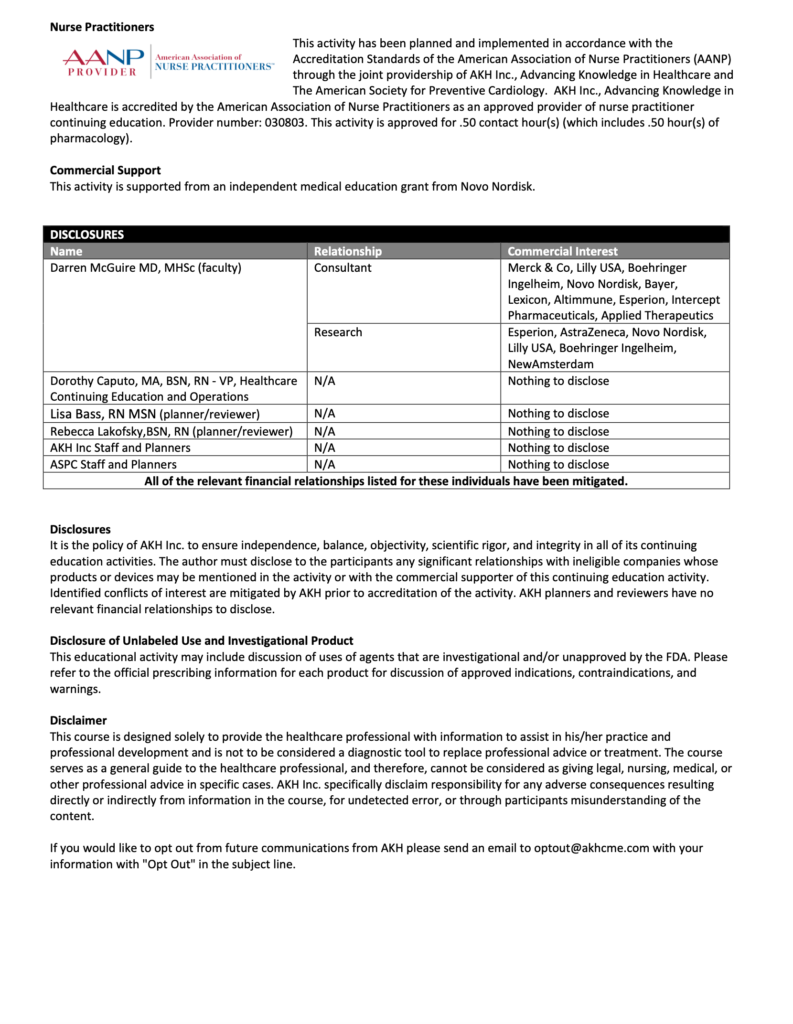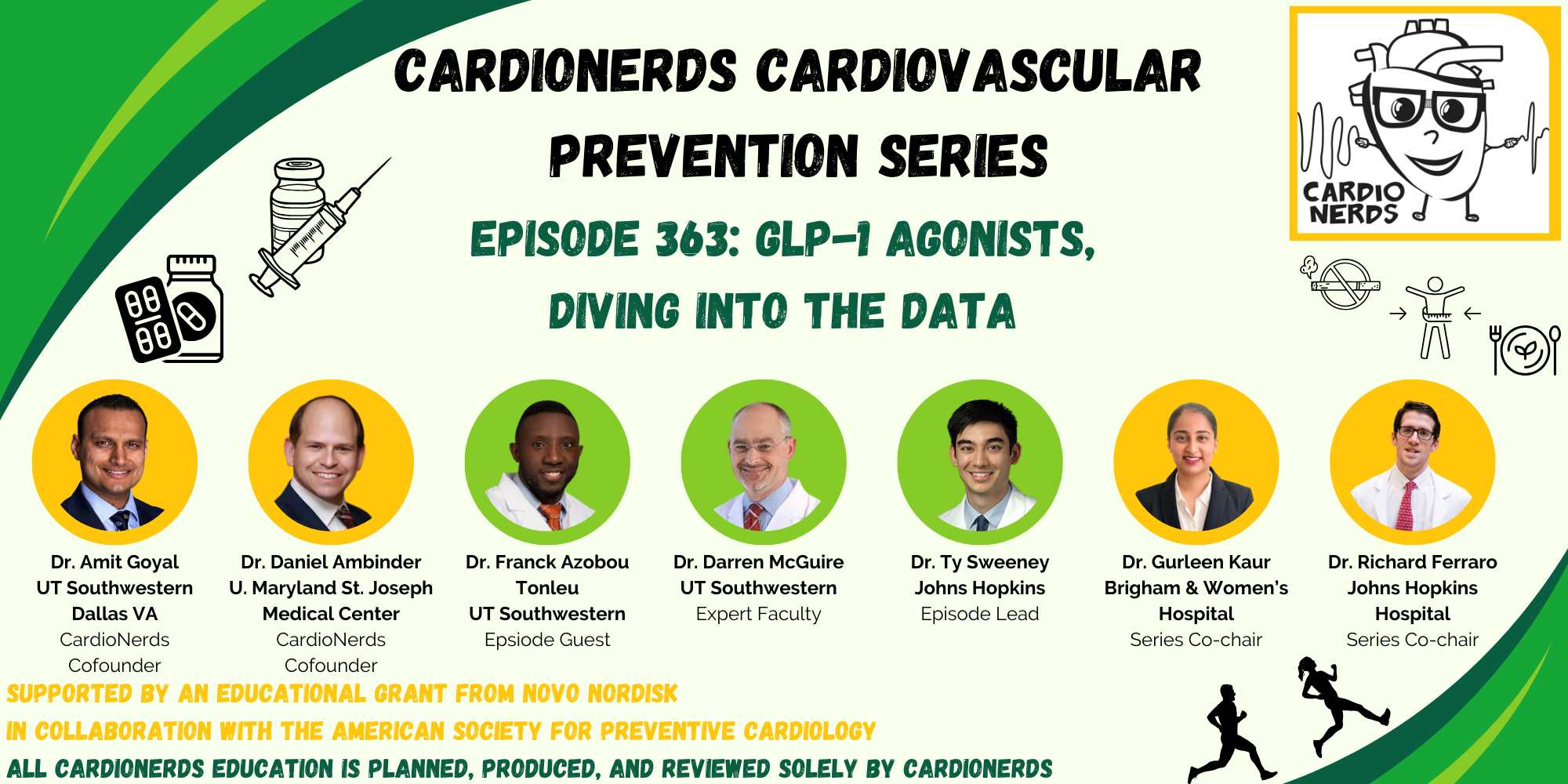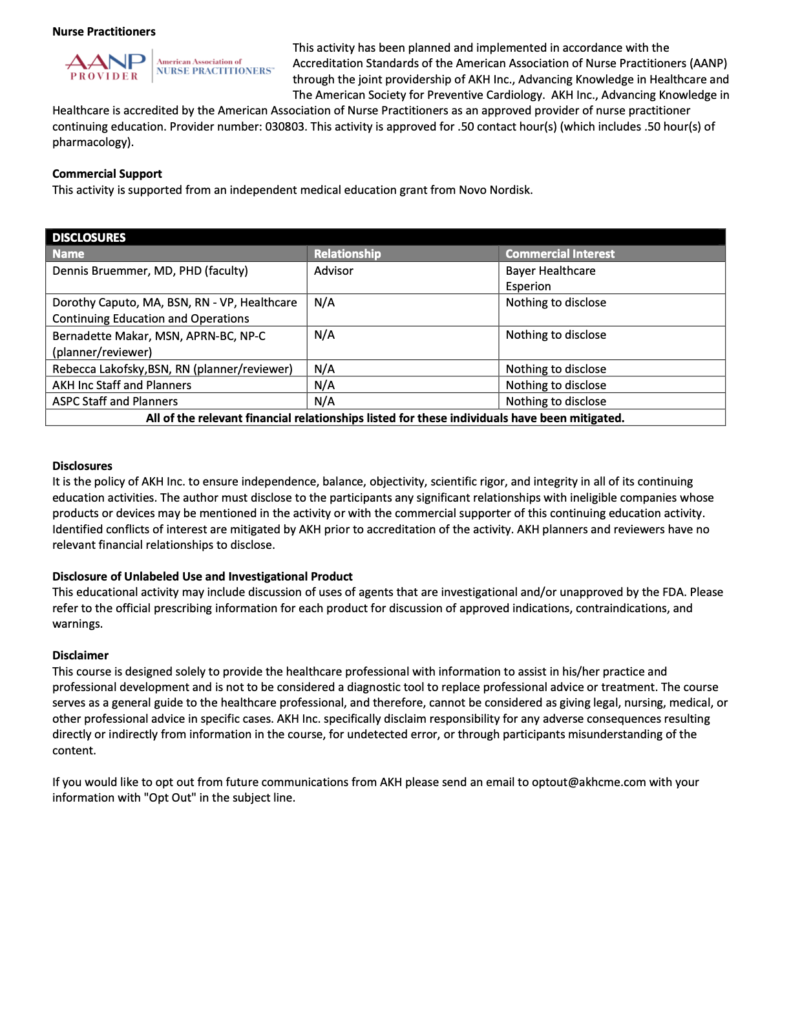
363. GLP-1 Agonists: Diving into the Data with Dr. Darren McGuire
Cardionerds: A Cardiology Podcast
Optimizing Diabetes and Heart Failure Management with GLP-1 Agonists and SGLT2 Inhibitors
The chapter explores the synergistic benefits of combining GLP-1 receptor agonists and SGLT2 inhibitors in diabetes and heart failure management, emphasizing their distinct mechanisms and positive outcomes. Discussions include the efficacy of GLP-1 agonists without metformin, hypoglycemia risks, and the evolving cardiovascular evidence supporting their usage. The chapter also addresses challenges in real-time application of evidence-based practices and advocates for proactive prescription of these medications by cardiologists.


Welcome back to the CardioNerds Cardiovascular Prevention Series, where we are continuing our discussion of Glucagon-like Peptide-1 Receptor Agonists (GLP-1 RAs). This class of medications is becoming a household name, not only for their implications for weight loss but also for their effect on cardiovascular disease. CardioNerds Dr. Ty Sweeney (CardioNerds Academy Faculty Member and incoming Cardiology Fellow at Boston Medical Center), Dr. Rick Ferraro (CardioNerds Academy House Faculty and Cardiology Fellow at Johns Hopkins Hospital), and special guest Dr. Franck Azobou (Cardiology Fellow at UT Southwestern) sat down with Dr. Darren McGuire (Cardiologist at UT Southwestern and Senior Editor of Diabetes and Vascular Disease Research) to discuss important trial data on GLP-1 RAs in patients with heart disease, as well as recent professional society guidelines on their use. Show notes were drafted by Dr. Ty Sweeney. Audio editing was performed by CardioNerds Intern student Dr. Diane Masket.
If you haven’t already, be sure to check out CardioNerds episode #350 where we discuss the basics and mechanism of action of GLP-1 RAs with Dr. Dennis Bruemmer.
This episode was produced in collaboration with the American Society of Preventive Cardiology (ASPC) with independent medical education grant support from Novo Nordisk. See below for continuing medical education credit.
Claim CME for this episode HERE.
US Cardiology Review is now the official journal of CardioNerds! Submit your manuscript here.

Pearls and Quotes – GLP-1 Agonists: Diving into the Data
- Patients with diabetes and clinical atherosclerotic cardiovascular disease (ASCVD) or who are at high risk of ASCVD benefit from treatment with a GLP-1 RA.
- For persons with sufficient ASCVD risk and type 2 diabetes, GLP-1 RAs and SGLT2 inhibitors can, and often should, be used in combination. “Just like we don’t consider ‘and/or’ for the four pillars of guideline-directed medical therapy for heart failure with reduced ejection fraction, we shouldn’t parcel out these two therapeutic options…it should be both.”
- Setting expectations with your patients regarding injection practices, side effects, and expected benefits can go a long way toward improving the patient experience with GLP-1 RAs.
- Utilize a multidisciplinary approach when caring for patients on GLP-1 RAs. Build a team with your patient’s primary care provider, endocrinologist, clinical pharmacist, and nurse.
- “This is really a cardiologist issue. These are no longer endocrinology or primary care drugs. We need to be prescribing them ourselves just like we did back in the nineties when we took over the statin prescriptions from the endocrinology domain…we need to lead the way.”
Show notes – GLP-1 Agonists: Diving into the Data
For which patients are GLP-1 RAs recommended to reduce the risk of major cardiac events?
- For patients with type 2 diabetes and ASCVD, starting a GLP-1 RA carries a Class 1, Level of Evidence A recommendation in the most recent ESC and ACC guidelines.
- For patients without diabetes or clinical ASCVD with an estimated 10-year risk of CVD exceeding 10%, consideration of starting a GLP-1 RA carries a Class 2b, Level of Evidence C recommendation to reduce CV risk.
- The STEP-HFpEF trial showed that among patients with obesity and HFpEF, once-weekly semaglutide may be beneficial in terms of weight loss and quality of life.
- The results of the FIGHT and LIVE trials question the utility and safety of liraglutide in treating patients with advanced HFrEF. Of the over 17,000 patients enrolled in the SELECT trial, about 25% had heart failure, of which about one-third had HFrEF. Stay tuned for sub-analyses from that trial for more info!
Can we still prescribe GLP-1 Ras in patients with well-controlled T2DM?
- The recommendation to start GLP-1 RAs for cardiovascular benefit in eligible patients is made irrespective of HbA1C.
- If A1c is very low, or if the patient is experiencing episodes of hypoglycemia, consider backing off background diabetes therapy, especially if they don’t confer CV benefit.
- Note, the recent ESC guidelines recommending SGLT2i and GLP-1RA therapy do so irrespective of background metformin therapy. This is supported by the ADA Standards of Care in Diabetes.
Is there evidence to suggest oral vs injectable GLP-1 RAs with respect to cardiac outcomes?
- The PIONEER-6 trial suggests cardiovascular benefit of oral semaglutide in patients with diabetes compared to placebo; however, the trial was only powered to assess safety.
- The ongoing SOUL trial is examining cardiovascular outcomes among patients being treated with oral semaglutide vs placebo with the primary outcome of time from randomization to the first occurrence of a major adverse CV event. Stay tuned!
- It is crucial that oral semaglutide be taken on an empty stomach, given its unique absorption and pharmacokinetics.
What side effects can patients expect when initiating GLP-1 RAs?
- Nausea is common after starting these medications, but this generally ameliorates after 1-2 weeks of therapy.
- Setting expectations with your patients ahead of time can go a long way to improving adherence.
- We do not have dose-response data to say whether sub-maximal doses of GLP-1 RAs (for example, in patients who do not want or cannot tolerate the full dose) are effective. That said, the SELECT trial suggests the benefits of starting GLP-1 RAs begin early, even at introductory doses. Therefore, if a patient truly cannot tolerate higher doses, it may be reasonable to titrate slowly or hold at a lower dose.
What does the literature say regarding the combined use of SGLT2 inhibitors and GLP-1 RAs?
- Sub-analyses examining the effect of background therapy when patients are randomized to receive the other vs. placebo suggest patients enjoy at least as good, if not better, outcomes from the combination of therapies.
- One of the first planned sub-analyses of SOUL will look at the potential additive effects of oral semaglutide alongside background SGLT2 inhibitor therapy.
References – GLP-1 Agonists: Diving into the Data
- Marx N, Federici M, Schütt K, et al. 2023 ESC Guidelines for the management of cardiovascular disease in patients with diabetes: Developed by the task force on the management of cardiovascular disease in patients with diabetes of the European Society of Cardiology (ESC). European Heart Journal. 2023;44(39):4043-4140. https://academic.oup.com/eurheartj/article/44/39/4043/7238227?login=false
- Virani SS, Newby LK, Arnold SV, et al. 2023 AHA/ACC/ACCP/ASPC/NLA/PCNA Guideline for the Management of Patients With Chronic Coronary Disease: A Report of the American Heart Association/American College of Cardiology Joint Committee on Clinical Practice Guidelines. Circulation. 2023;148(9):e9-e119. https://www.ahajournals.org/doi/10.1161/CIR.0000000000001168
- ElSayed NA, Aleppo G, Aroda VR, et al. 10. Cardiovascular Disease and Risk Management: Standards of Care in Diabetes—2023. Diabetes Care. 2022;46(Supplement_1):S158-S190. https://diabetesjournals.org/care/article/46/Supplement_1/S158/148038/10-Cardiovascular-Disease-and-Risk-Management
- Husain M, Birkenfeld AL, Donsmark M, et al. Oral Semaglutide and Cardiovascular Outcomes in Patients with Type 2 Diabetes. New England Journal of Medicine. 2019;381(9):841-851. https://www.nejm.org/doi/full/10.1056/NEJMoa1901118
- McGuire DK, Busui RP, Deanfield J, et al. Effects of oral semaglutide on cardiovascular outcomes in individuals with type 2 diabetes and established atherosclerotic cardiovascular disease and/or chronic kidney disease: Design and baseline characteristics of SOUL, a randomized trial. Diabetes Obes Metab. 2023;25(7):1932-1941. https://pubmed.ncbi.nlm.nih.gov/36945734/
- Kosiborod MN, Abildstrøm SZ, Borlaug BA, et al. Semaglutide in Patients with Heart Failure with Preserved Ejection Fraction and Obesity. N Engl J Med. 2023;389(12):1069-1084. https://pubmed.ncbi.nlm.nih.gov/37622681/
- Jorsal A, Kistorp C, Holmager P, et al. Effect of liraglutide, a glucagon-like peptide-1 analogue, on left ventricular function in stable chronic heart failure patients with and without diabetes (LIVE)-a multicentre, double-blind, randomised, placebo-controlled trial. Eur J Heart Fail. 2017;19(1):69-77. https://pubmed.ncbi.nlm.nih.gov/27790809/
- Margulies KB, Hernandez AF, Redfield MM, et al. Effects of Liraglutide on Clinical Stability Among Patients With Advanced Heart Failure and Reduced Ejection Fraction: A Randomized Clinical Trial. JAMA. 2016;316(5):500-508. https://jamanetwork.com/journals/jama/article-abstract/2540402




